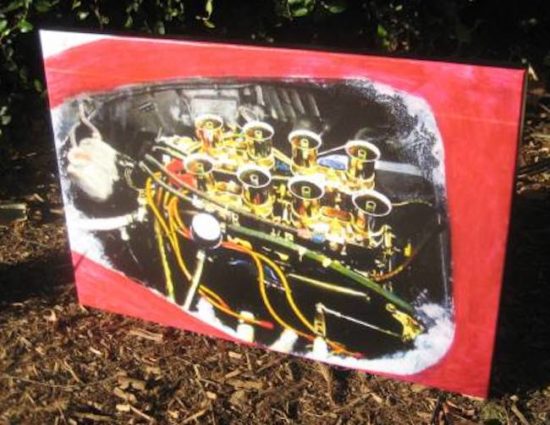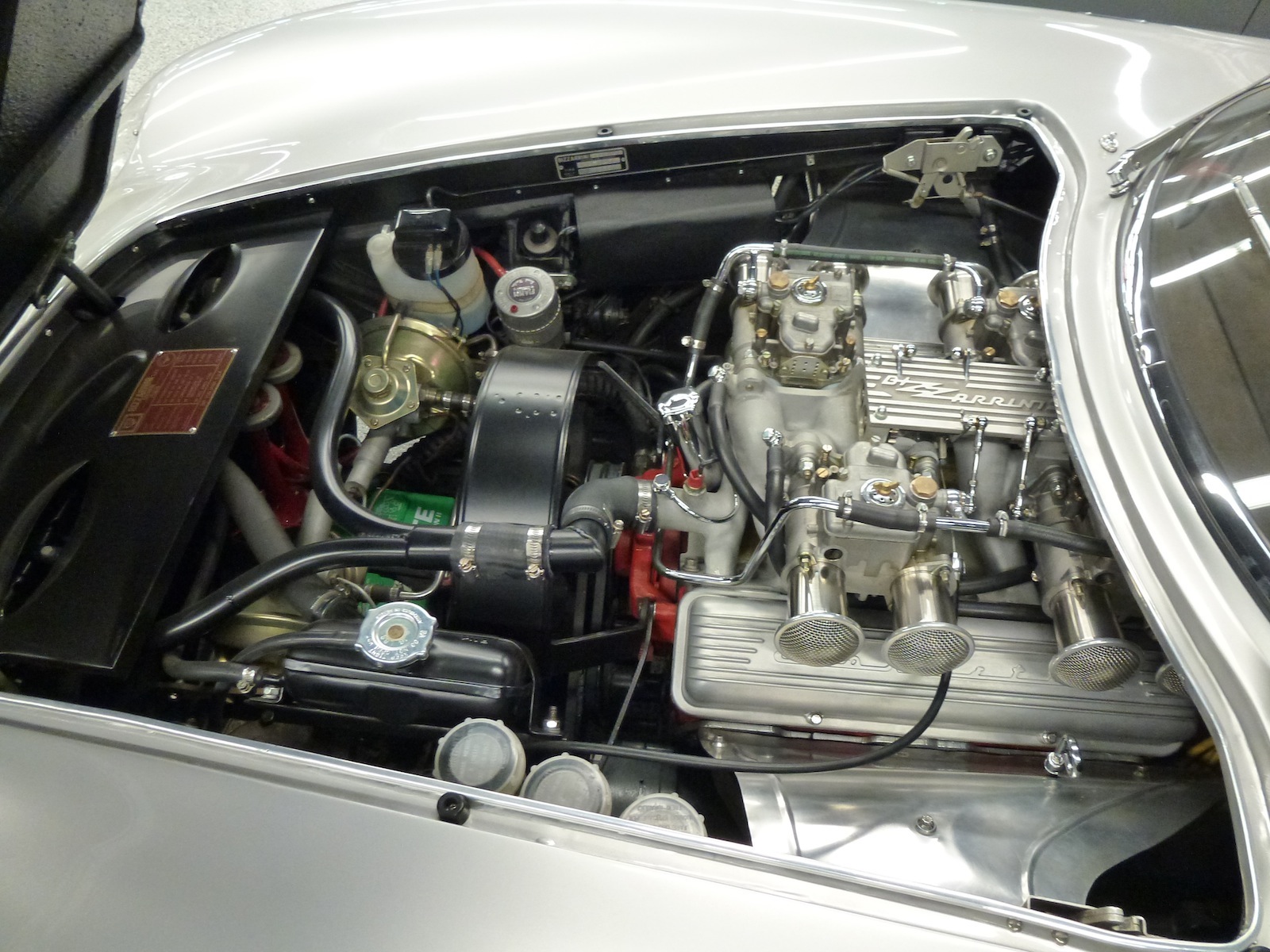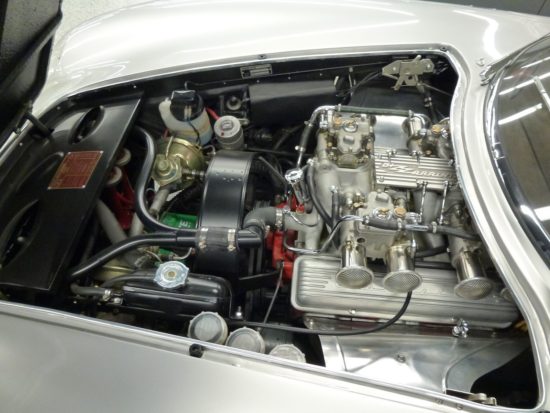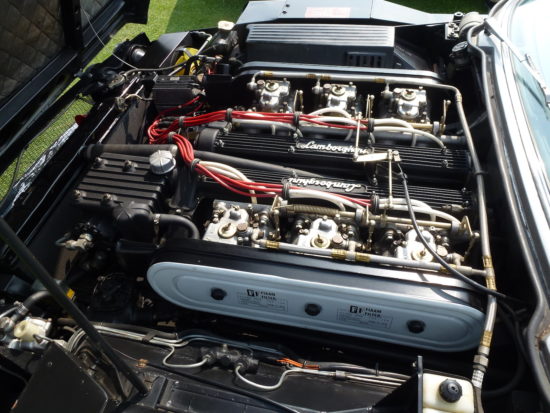by Wallace Wyss –
When I made my first engine painting (GTO engine six dual throat Webers) I picked that engine because it had real eye appeal, and ya gotta love it because each carb has two throats, so basically each of the twelve cylinders has its own air supply. I liked that look a lot more than the tamer street Ferraris with three two barrel Webers.
Then we come to American V8s. Technologically they suffered, image-wise because they were so crude – iron block instead of alloy. Pushrods instead of overhead cams, four into one exhaust pipes per side instead of individual pipes joining a bigger side pipe down below. But then Giotto Bizzarrini came along, developing a race car for Iso. His Iso A3/C had four sidedraft dual throat 45 DCOE Webers. That gave it the same amount of air intake per cylinder as a Ferrari 250GTO.
Shelby’s ace mechanic, Phil Remington, working in Dean Moon’s shop back in ’62 had welded up a side draft intake manifold for the first 260 Cobra (CSX2000) but for some reason it was rejected in favor of a downdraft. So most racing Cobra small blocks raced with downdraft Webers. When it came to the big block I believe most had a humongous four barrel Holley through there was one race car that had Webers (and was therefore called “the dragon” because it would backfire flames out the hood scoop!)
I was able to find plenty of photo references for Webers on a Cobra but on Iso Grifo A3/Cs and Bizzarrinis with side drafts, the problem is some American owners 60 years later have installed some hot rod intake manifold that does not have the flat top box in the center with springs pulling the carbs open from the center (hence the name “center pull” ). But I couldn’t complete the painting because I can’t find a picture of a dead stock ’65 Iso Grifo A3/C with its original Weber setup.
I didn’t realize Webers could be such a challenge until I read Rick Kopec’s description in a 2008 Shelby American magazine. Kopec explains the virtue of the Webers is that they’re “infinitely tunable.” He explains: “With a typical Holley 4-barrel, you can change the jets and fiddle with the idle screws to get the engine running evenly. The float levels need to be right and the linkage should operate smoothly but if everything is working right the engine should be turn-key and trouble-free. But with Webers, “infinitely tunable” is a double-edged sword. There are a lot of components that can be adjusted or changed: main jets, idle jets, jet carriers, needles and seats, air correctors, chokes, emulsion tubes and secondary venturis.
Of course, with four carburetors—and each with two barrels—that means that you multiply everything by eight. Sometimes when you make one change, it affects other things (the oft-described “Make It Worse” scenario). This can lead to Weber-dementia, which often results in hasty removal of the entire system and selling it to the first person who comes along and makes an offer, no matter how low-ball it is.
“It is also the stuff of nightmares, because if the new owner is trying to figure out how the system works on his own, unless he is very lucky or very well versed in the concept of a fuel delivery system, he is heading for the painful reality that, like root canal, brain surgery or a clogged septic system, Weber carburetors are something best left to a professional.”
Despite his frustrations, Kopec got seduced by Webers and installed them on his early Shelby Mustang. “Eventually your Webers will sing to you and you’re going to love that song. When 6S118 had a 4-barrel, it was possible to squeeze 18 MPG out of it if I drove like an old lady. Once I put Webers on it the mileage immediately dropped to 9 MPG because I never got tired of hearing that banshee wail. But I did get tired of stopping to fill up every 150 miles. The answer was simple: I fabricated a 32-gal. R-Model gas tank. So while that didn’t improve the mileage, it extended my driving range to 300 miles on a tankful—the same that I was getting with the 4-barrel. The only difference was now it costs twice as much to go the same distance. But the Webers make up for that minor inconvenience.”
There’s one more Weber equipped engine of the ’60s I am going to portray in oils–the Porsche Carrera flat four which had a beautiful rounded engine fan cover.
I know we are reaching the end of ICE engines but one of the great thrills is driving a Weber equipped one and only hearing that exhaust throb but hearing those Webers greedily suck in the air (and when they weren’t tuned right, making the engine spit, cough and backfire…) I experienced that once in the Malibu tunnel, in my Ferrari V-12 six Weber equipped C4, first winding out to 8000 rpm, then letting off the gas and hearing not only the booming exhaust roar but the spitting, coughing and backfiring. God, it was wonderful…
Let us know what you think in the Comments.
THE AUTHOR Wallace Wyss is a commentator on cars new and collectible on KUCT FM’s Autotalk show. As a fine artist, his portraits of classic cars are seen are the Mecum auctions.

This portrait of a Cobra 289 with Webers is available as a 20″ x 30″ giclee canvas print. Write malibucarart@gmail.com






Here is a Weber equipped engine that very few of your readers have ever seen. This is an all aluminum 377 cubic inch Grand Sport engine out of George Wintersteen’s 1963 Grand Sport Corvette that now resides in the Simeone Museum in Philadelphia. These were the original engines supplied to Grand Sports before they switched to Traco built 427’s.
That GTO combo of 6 dual-throat Webers, 2 distributors with 3-points each, and 24 valves on 2 cams, was an absolute BEAR to tune! The chief mechanic on my GTO, John Sabiston, mastered the art and always produced a motor that ran like a fine watch. And it would “pull stumps” from about 3500 to as high as you dared to go. At 9000 … still pulling … though inadvisable.
The amazing thing about John’s story, though, is that his mastery was instinctive and honed by long experience. He had been an early drag racer on Long Island—having built the first twin-V8 rail to run at Islip. And he had wrenched for John Bentley and Jack Gordon on their index-winning cars. But before January of 1964, he had never touched a Ferrari V12!!
He never hesitated. There were no reference manuals, so he picked the mechanics’ brains at Luigi’s shop and applied his skills. His first rebuild was started just to put the car on the trailer in NY, and ran for real at Daytona a week later. Like … well … a watch. Sabiston Magic!
As you say, that long rank of Webers inspires awe and a sense of raw power that ‘s hard to beat. All Hail to Columbo and Bizzarrini !!
Standard equipment on Australia’s Chrysler Valiant Charger E49 , three 45ml twin throat webers on 165 six cylinder hemi motor . World’s fastest 6 cylinder production car at that time .
Wow, I did not know that.
They were A$3975 new in 1972 and came with a Borg Warner 4 speed and a Borg Warner diff . In standard spec they were rated at 302HP , but could easily be modified to develop 450HP . In 1975 I bought a 1972 model with 22,000 k’s on it for $1,000 . It could beat almost any car on our roads in a straight line , but in corners and the braking department it was dangerous . I sold it for 4 grand & one now you could name your own price for it .
I’ve been working on and selling parts for Weber and PMO carbs for over 50 years. My first experience was as a apprentice mechanic working on Porsches (and VW’s) at a dealership. In addition to the awesome cars you have mentioned, there have also been more blue collar sports cars like MGs, Tr’s, Alfa’s etc – all of which benefited from the use of Weber’s once tuned properly. The tuning procedure is very specific and must be done in a specific order to be successful. When the procedure is followed, they can be a joy to work on, and listen to. In addition to the various Air screws that can be adjusted, the linkage and float levels must also be right. But too many amateur’s open the hood, see those awesome Webers/PMOs and start turning screws. That is never successful unless you are extremely lucky. In addition to the Linkage and Float Levels, the Ignition the magical song must be in proper adjustment with all components working as they should. Only then can there be any hope of enjoying a properly tuned engine and hearing the lovely sound of 6 (or more) throats pulling vast volumes of.air thru the Webers into and through the engine.
Sorry – my previous message was confused by my poor vision – it should read, “the Ignition must be in proper adjustment with all components working as they should. Only then can there be any hope of enjoying a properly tuned engine and hearing the lovely, magical song of 6 (or more) throats pulling vast volumes of.air thru the Webers into and through the engine.
Sorry about that. (BTW, it’d be nice if the option of editing the post by the original author)
Reply,
Larry, so what is the proper procedure. I’m just putting a 32/36 on a old 4 cylinder Scout. Or a site or book to read? Thanks